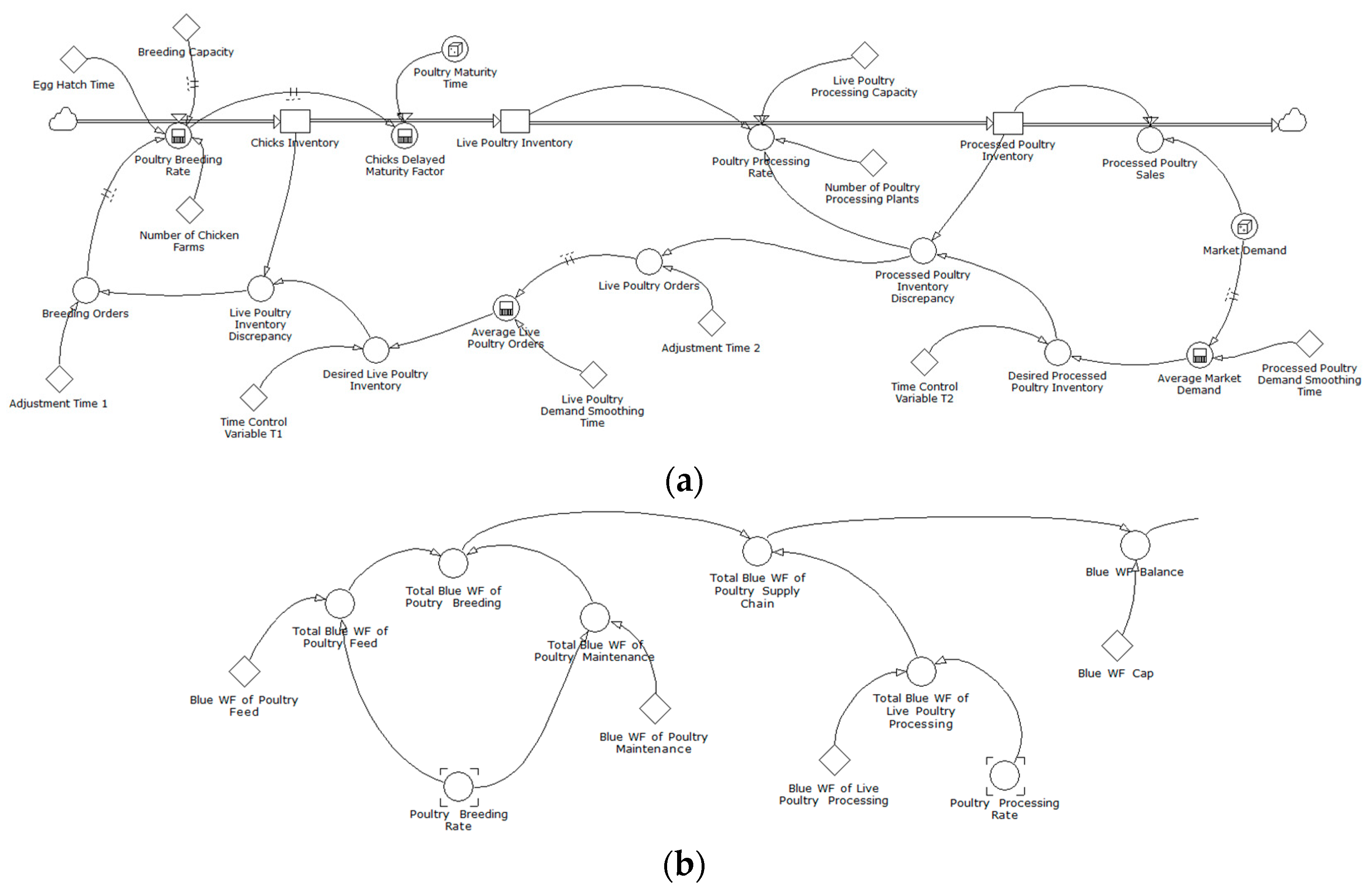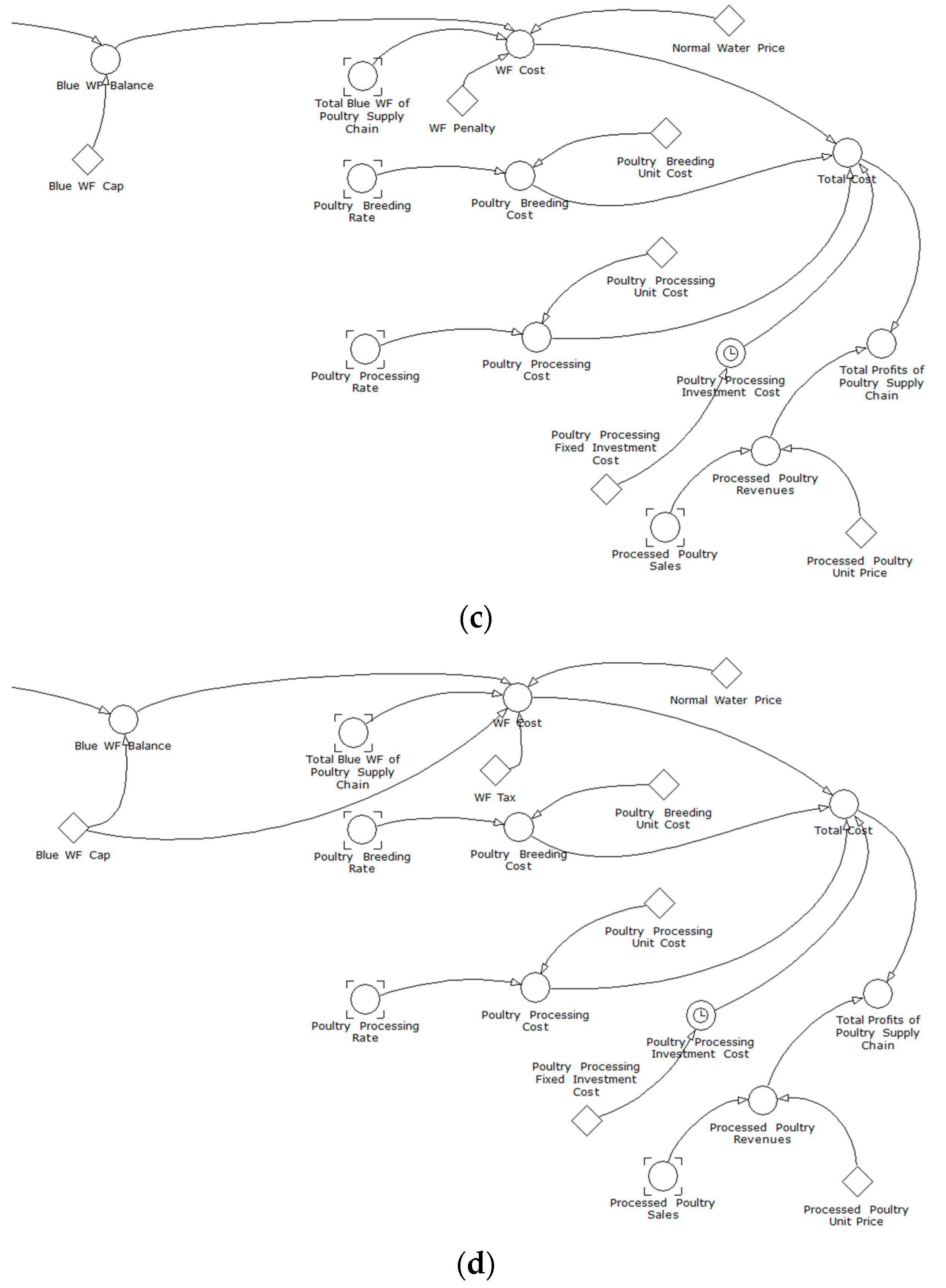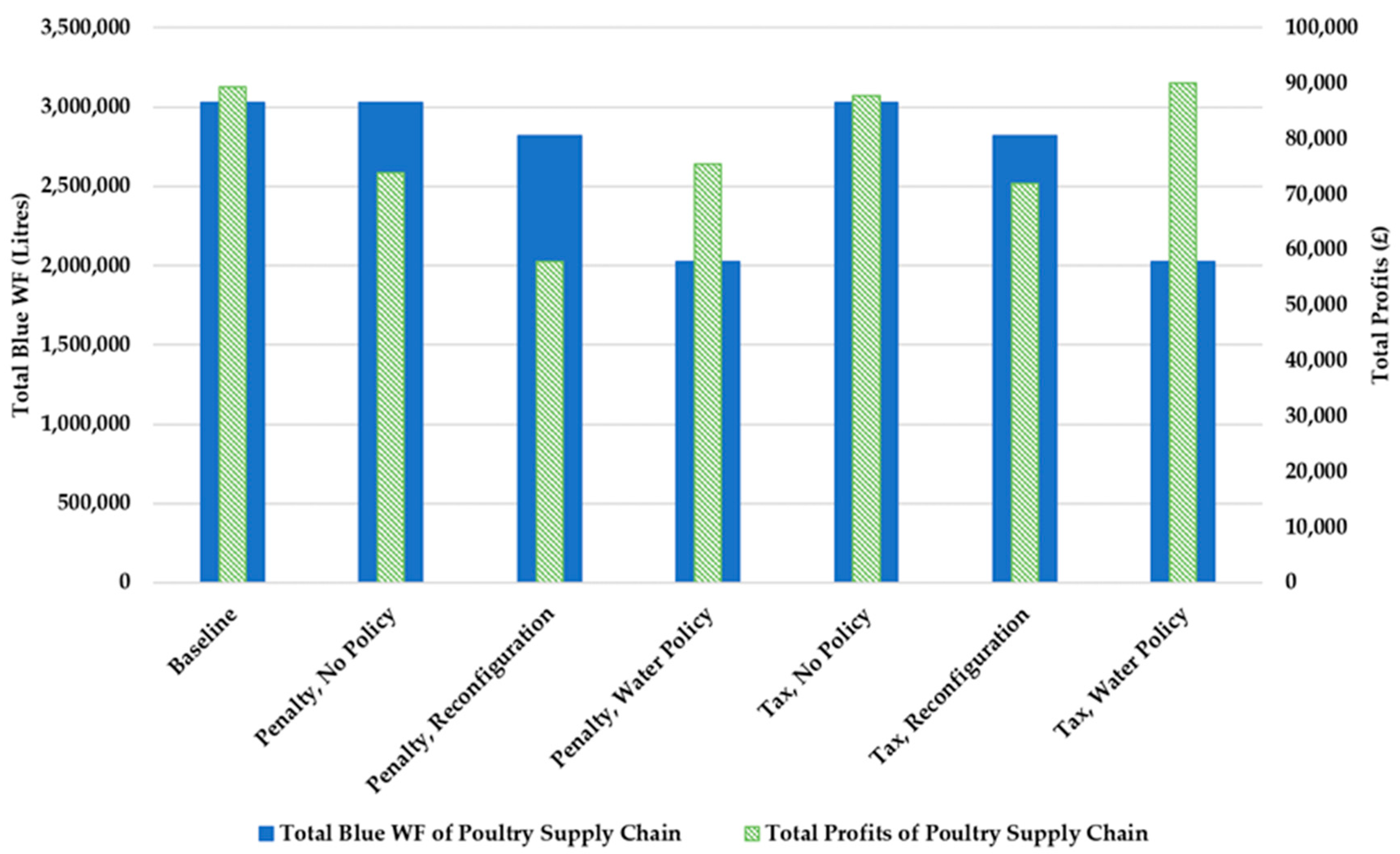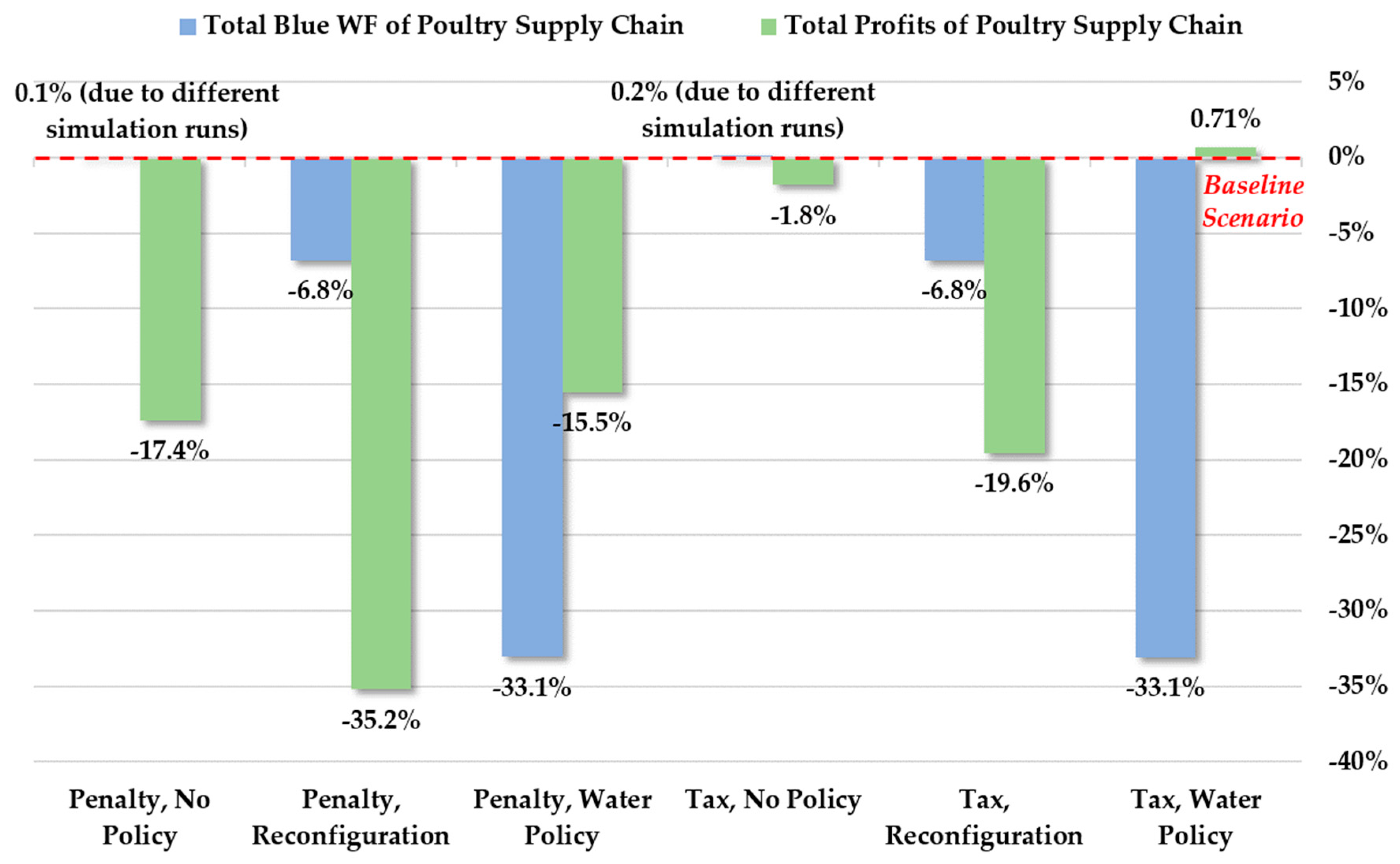Blue Water Footprint Management in a UK Poultry Supply Chain under Environmental Regulatory Constraints
Abstract
:1. Introduction
2. Materials and Methods
3. Results
4. Discussion
4.1. Business Decision-Making Insights
4.2. Regulatory Policy-Making Insights
5. Conclusions
Acknowledgments
Author Contributions
Conflicts of Interest
Appendix A
| Feedback Loop | Causal Effect Sequence |
|---|---|
| R1 | Poultry Breeding Rate → Chicks Maturity Rate → Chicks Inventory → Live Poultry Inventory Discrepancy → Poultry Breeding Rate |
| R2 | Poultry Breeding Rate → Chicks Maturity Rate → Chicks Inventory → Live Poultry Inventory Discrepancy → Breeding Orders → Poultry Breeding Rate |
| B1 | Poultry Breeding Rate → Chicks Inventory → Live Poultry Inventory Discrepancy → Poultry Breeding Rate |
| B2 | Poultry Breeding Rate → Chicks Inventory → Live Poultry Inventory Discrepancy → Breeding Orders → Poultry Breeding Rate |
| B3 | Poultry Breeding Rate → Chicks Maturity Rate → Live Poultry Inventory → Poultry Processing Rate → Processed Poultry Inventory → Processed Poultry Inventory Discrepancy → Live Poultry Orders → Average Live Poultry Orders → Desired Live Poultry Inventory → Live Poultry Inventory Discrepancy → Poultry Breeding Rate |
| B4 | Poultry Breeding Rate → Chicks Maturity Rate → Live Poultry Inventory → Poultry Processing Rate → Processed Poultry Inventory → Processed Poultry Inventory Discrepancy → Live Poultry Orders → Average Live Poultry Orders → Desired Live Poultry Inventory → Live Poultry Inventory Discrepancy → Breeding Orders → Poultry Breeding Rate |
| B5 | Live Poultry Inventory → Poultry Processing Rate → Live Poultry Inventory |
| B6 | Processed Poultry Inventory → Processed Poultry Sales → Processed Poultry Inventory |
| B7 | Processed Poultry Inventory → Processed Poultry Inventory Discrepancy → Poultry Processing Rate → Processed Poultry Inventory |
| Name | Type | Unit | Definition |
|---|---|---|---|
| Average Live Poultry Orders | auxiliary | chicken/month | DELAYINF(‘Live Poultry Orders’, ‘Live Poultry Demand Smoothing Time’, 1) |
| Average Market Demand | auxiliary | chicken/month | DELAYINF(‘Market Demand’, ’Processed Poultry Demand Smoothing Time’, 1) |
| Blue WF Balance | auxiliary | litre | ‘Total Blue WF of Poultry Supply Chain’-’Blue WF Cap’ |
| Breeding Orders | auxiliary | chicken/month | INTEGER((‘Live Poultry Inventory Discrepancy’/’Adjustment Time 1′)) * TIMESTEP |
| Chicks Delayed Maturity Factor | auxiliary | chicken | DELAYMTR(‘Poultry Breeding Rate’, ’Poultry Maturity Time’,6) |
| Desired Live Poultry Inventory | auxiliary | chicken/month | INTEGER(‘Average Live Poultry Orders’*’Time Control Variable T1′)/TIMESTEP |
| Desired Processed Poultry Inventory | auxiliary | chicken/month | INTEGER((‘Average Market Demand’*’Time Control Variable T2′))/TIMESTEP |
| Live Poultry Inventory Discrepancy | auxiliary | chicken/month | MAX(‘Desired Live Poultry Inventory’-’Chicks Inventory’, 0<<chicken>>) |
| Live Poultry Orders | auxiliary | chicken/month | INTEGER((‘Processed Poultry Inventory Discrepancy’/’Adjustment Time 2′)) * TIMESTEP |
| Market Demand | auxiliary | chicken/month | INTEGER(((NORMAL(1.36<<chicken>>, 0.3<<chicken>>))/12) * 6,5300,000/150)/TIMESTEP |
| Poultry Breeding Cost | auxiliary | pound | ‘Poultry Breeding Rate’*’Poultry Breeding Unit Cost’ |
| Poultry Breeding Rate | auxiliary | chicken | MIN(DELAYMTR(‘Breeding Capacity’,’Egg Hatch Time’, 3),INTEGER(DELAYMTR(‘Breeding Orders’, ’Egg Hatch Time’, 3))) * ’Number of Chicken Farms’ |
| Poultry Maturity Time | auxiliary | month | RANDOM(1.25,1.75) * TIMESTEP |
| Poultry Processing Cost | auxiliary | pound | ‘Poultry Processing Rate’ * ’Poultry Processing Unit Cost’ |
| Poultry Processing Investment Cost | auxiliary | pounds | PULSE(‘Poultry Processing Fixed Investment Cost’, 0<<month>>, 900,000<<month>>) |
| Poultry Processing Rate | auxiliary | chicken | INTEGER(MIN(‘Live Poultry Inventory’,’Processed Poultry Inventory Discrepancy’, ’Live Poultry Processing Capacity’ * ’Number of Poultry Processing Plants’)) |
| Processed Poultry Inventory Discrepancy | auxiliary | chicken/month | INTEGER(MAX(‘Desired Processed Poultry Inventory’-’Processed Poultry Inventory’, 0<<chicken>>)) |
| Processed Poultry Sales | auxiliary | chicken | INTEGER(MIN(‘Processed Poultry Inventory’,’Market Demand’)) |
| Processed Poultry Revenues | auxiliary | pound | ‘Processed Poultry Sales’ * ’Processed Poultry Unit Price’ |
| Total Blue WF of Live Poultry Processing | auxiliary | litre | ‘Blue WF of Live Poultry Processing’ * ’Poultry Processing Rate’ |
| Total Blue WF of Poultry Feed | auxiliary | litre | ‘Poultry Breeding Rate’ * ’Blue WF of Poultry Feed’ |
| Total Blue WF of Poultry Maintenance | auxiliary | litre | ‘Poultry Breeding Rate’ * ’Blue WF of Poultry Maintenance’ |
| Total Blue WF of Poultry Supply Chain | auxiliary | litre | ‘Total Blue WF of Poultry Breeding’ + ’Total Blue WF of Live Poultry Processing’ |
| Total Blue WF of Poultry Breeding | auxiliary | litre | ‘Total Blue WF of Poultry Feed’ + ’Total Blue WF of Poultry Maintenance’ |
| Total Cost | auxiliary | pound | Poultry Breeding Cost’+’Poultry Processing Cost’ + ’WF Cost’ + 0 * ’Poultry Processing Investment Cost’ (No Policy/Supply Chain Reconfiguration Policy) or ‘Poultry Breeding Cost’ + ’Poultry Processing Cost’ + ’WF Cost’ + 1 * ’Poultry Processing Investment Cost’ (Water Management Policy) |
| Total Profits of Poultry Supply Chain | auxiliary | pound | ‘Processed Poultry Revenues’-’Total Cost’ |
| WF Cost (Baseline Case) | auxiliary | pound | ‘Total Blue WF of Poultry Supply Chain’*’Normal Water Price’ |
| WF Cost (WF Penalty Case) | auxiliary | pound | IF(‘Blue WF Balance’ ≤ 0<<litres>>,’Total Blue WF of Poultry Supply Chain’*’Normal Water Price’, ’Total Blue WF of Poultry Supply Chain’ * ’Normal Water Price’ + ’WF Penalty’) |
| WF Cost (WF Tax Case) | auxiliary | pound | IF(‘Blue WF Balance’ ≤ 0<<litres>>,’Total Blue WF of Poultry Supply Chain’*’Normal Water Price’, ’Blue WF Cap’*’Normal Water Price’ + (‘Total Blue WF of Poultry Supply Chain’-’Blue WF Cap’) * ’Normal Water Price’ * (1 + ’WF Tax’)) |
| Adjustment Time 1 | constant | month | (0.75) * TIMESTEP |
| Adjustment Time 2 | constant | month | (0.75) * TIMESTEP |
| Blue WF Cap | constant | litre | 500,000<<litres>> |
| Blue WF of Live Poultry Processing | constant | litre/chicken | 8<<gallon/chicken>>*4.54 // 1 gallon = 4.54 litres (No Policy) or 3.5<<gallon/chicken>>*4.54 // 1 gallon = 4.54 litres (Water Management Policy) |
| Blue WF of Poultry Feed | constant | litre/chicken | 2.5<<litre/kilogram>>*2.6<<kilogram/chicken>> |
| Blue WF of Poultry Maintenance | constant | litre/chicken | 6.2<<litre/kilogram>>*2.6<<kilogram/chicken>> |
| Breeding Capacity | constant | chicken | 11,000<<chicken>> |
| Egg Hatch Time | constant | month | 0.7*TIMESTEP |
| Live Poultry Demand Smoothing Time | constant | month | 2*TIMESTEP |
| Live Poultry Processing Capacity | constant | chicken | 12,000<<chicken>> |
| Normal Water Price | constant | pound/litre | 2.2525<<pounds/litre>>/1000 |
| Number of Chicken Farms | constant | (number) | 5 |
| Number of Poultry Processing Plants | constant | (number) | 7 |
| Poultry Breeding Unit Cost | constant | pound/chicken | 1.126<<pounds/chicken>> |
| Poultry Processing Fixed Investment Cost | constant | pound | 50,000<<pounds>> |
| Poultry Processing Unit Cost | constant | pound/chicken | 0.6<<pounds/chicken>> |
| Processed Poultry Demand Smoothing Time | constant | month | 2*TIMESTEP |
| Processed Poultry Unit Price | constant | pound/chicken | 3.95<<pounds/chicken>> |
| Time Control Variable T1 | constant | month | 6*TIMESTEP |
| Time Control Variable T2 | constant | month | 3*TIMESTEP (No Policy) or 2*TIMESTEP (Supply Chain Reconfiguration Policy) |
| WF Penalty | constant | pounds | 15766<<pounds>> |
| WF Tax | constant | % | 35% |
| Chicks Inventory | level | chicken | 1000<<chicken>> |
| Live Poultry Inventory | level | chicken | 1000<<chicken>> |
| Processed Poultry Inventory | level | chicken | 1000<<chickens>> |
References
- Hoekstra, A.Y.; Chapagain, A.K. Globalization of Water: Sharing the Planet’s Freshwater Resources, 1st ed.; Wiley-Blackwell: Hoboken, NJ, USA, 2007; ISBN 978-1-4051-6335-4. [Google Scholar]
- Mekonnen, M.M.; Hoekstra, A.Y. A global assessment of the water footprint of farm animal products. Ecosystems 2012, 15, 401–415. [Google Scholar] [CrossRef]
- Hoekstra, A.Y.; Mekonnen, M.M. The water footprint of humanity. Proc. Natl. Acad. Sci. USA 2012, 109, 3232–3237. [Google Scholar] [CrossRef] [PubMed]
- Liu, J.; Savenije, H.H.G. Food consumption patterns and their effect on water requirement in China. Hydrol. Earth Syst. Sci. 2008, 12, 887–898. [Google Scholar] [CrossRef]
- FAO (Food and Agriculture Organization). The State of Food and Agriculture–Leveraging Food Systems for Inclusive Rural Transformation; Food and Agriculture Organization: Rome, Italy, 2017. [Google Scholar]
- Aivazidou, E.; Tsolakis, N.; Vlachos, D.; Iakovou, E. The emerging role of water footprint in supply chain management: A critical literature synthesis and a hierarchical decision-making framework. J. Clean Prod. 2016, 137, 1018–1037. [Google Scholar] [CrossRef]
- UK Government. Available online: https://www.gov.uk/government/collections/poultry-and-poultry-meat-statistics#documents (accessed on 5 December 2017).
- Ibidhi, R.; Hoekstra, A.Y.; Gerbens-Leenes, P.W.; Chouchane, H. Water, land and carbon footprints of sheep and chicken meat produced in Tunisia under different farming systems. Ecol. Indic. 2017, 77, 304–312. [Google Scholar] [CrossRef]
- Gerbens-Leenes, P.W.; Mekonnen, M.M.; Hoekstra, A.Y. The water footprint of poultry, pork and beef: A comparative study in different countries and production systems. Wat. Resour. Ind. 2013, 1–2, 25–36. [Google Scholar] [CrossRef]
- Miglietta, P.-P.; De Leo, F.; Ruberti, M.; Massari, S. Mealworms for food: A Water Footprint Perspective. Sustainability 2015, 7, 6190–6203. [Google Scholar] [CrossRef]
- Harris, F.; Green, R.F.; Joy, E.J.M.; Kaytz, B.; Haines, A.; Dangour, A.D. The water use of Indian diets and socio-demographic factors related to dietary blue water footprint. Sci. Total Environ. 2017, 587–588, 128–136. [Google Scholar] [CrossRef] [PubMed]
- Rainbow Chicken Limited. Available online: http://www.rclfoods.com/sites/default/files/2012sustainability.pdf (accessed on 5 December 2017).
- Pilgrim’s. Available online: http://sustainability.pilgrims.com/mobile/index.html#p=96 (accessed on 5 December 2017).
- The Guardian. Available online: https://www.theguardian.com/sustainable-business/farmers-guidance-sustainable-water-management-leaf (accessed on 5 December 2017).
- Hoekstra, A.Y. The Water Footprint of Modern Society, 1st ed.; Routledge: Abingdon, UK, 2013; ISBN 978-1-8497-1427-3. [Google Scholar]
- European Union, 2000. Available online: http://eur-lex.europa.eu/resource.html?uri=cellar:5c835afb-2ec6-4577-bdf8-756d3d694eeb.0004.02/DOC_1&format=PDF (accessed on 5 December 2017).
- Hoekstra, A.Y.; Chapagain, A.K.; Aldaya, M.M.; Mekonnen, M.M. The Water Footprint Assessment Manual—Setting the Global Standard, 1st ed.; Earthscan: London, UK, 2011. [Google Scholar]
- Miglietta, P.-P.; Toma, P.; Fanizzi, F.-P.; De Donno, A.; Coluccia, B.; Migoni, D.; Bagordo, F.; Serio, F. A Grey Water Footprint Assessment of Groundwater Chemical Pollution: Case Study in Salento (Southern Italy). Sustainability 2017, 9, 799. [Google Scholar] [CrossRef]
- Pfister, S.; Boulay, A.-M.; Berger, M.; Hadjikakou, M.; Motoshita, M.; Hess, T.; Ridoutt, B.; Weinzettel, J.; Scherer, L.; Döll, P.; et al. Understanding the LCA and ISO water footprint: A response to Hoekstra (2016) “A critique on the water-scarcity weighted water footprint in LCA”. Ecol. Indic. 2017, 72, 352–359. [Google Scholar] [CrossRef]
- Boulay, A.-M.; Bare, J.; Benini, L.; Berger, M.; Lathuillière, M.J.; Manzardo, A.; Margni, M.; Motoshita, M.; Núñez, M.; Pastor, A.-V.; et al. The WULCA consensus characterization model for water scarcity footprints: assessing impacts of water consumption based on available water remaining (AWARE). Int. J. Life Cycle Assess. 2018, 23, 368–378. [Google Scholar] [CrossRef]
- Aivazidou, E.; Tsolakis, N.; Iakovou, E.; Vlachos, D. Water footprint management policies for agrifood supply chains: A critical taxonomy and a System Dynamics modelling approach. Chem. Eng. Trans. 2015, 43, 115–118. [Google Scholar] [CrossRef]
- Nabavi, E.; Daniell, K.A.; Najafi, H. Boundary matters: The potential of system dynamics to support sustainability? J. Clean Prod. 2017, 140, 312–323. [Google Scholar] [CrossRef]
- Forrester, J.W. Industrial Dynamics, 1st ed.; The MIT Press: Cambridge MA, USA, 1961. [Google Scholar]
- Akil, R.; Zakaria, A.H. Egg laying characteristics, egg weight, embryo development, hatching weight and post-hatch growth in relation to oviposition time of broiler breeders. Anim. Reprod. Sci. 2015, 156, 103–110. [Google Scholar] [CrossRef] [PubMed]
- European Food Safety Authority. Scientific opinion on the influence of genetic parameters on the welfare and the resistance to stress of commercial broilers. EFSA J. 2010, 8, 1666–1747. [Google Scholar] [CrossRef]
- Aviagen. Available online: http://en.aviagen.com/assets/Uploads/Env-MgtRearing.pdf (accessed on 5 December 2017).
- Kist, L.T.; Moutaqi, S.E.; Machado, Ê.L. Cleaner production in the management of water use at a poultry slaughterhouse of Vale do Taquari, Brazil: A case study. J. Clean Prod. 2009, 17, 1200–1205. [Google Scholar] [CrossRef]
- Agriculture and Horticulture Development Board. Poultry pocketbook. Available online: https://pork.ahdb.org.uk/media/271530/poultry-pocketbook-2016.pdf (accessed on 5 December 2017).
- Sheppard, A. The Structure and Economics of Broiler Production in England. Available online: https://ore.exeter.ac.uk/repository/bitstream/handle/10036/67675/Brreport.pdf?sequence=2 (accessed on 5 December 2017).
- Ecotrust. Differentiated Cost of Production in the Northwest: An Analysis of Six Food Categories. Available online: https://ecotrust.org/media/CFFP_chicken_8_16_16.pdf (accessed on 5 December 2017).
- Thames Water. Charges Schedule 2017-2018: For the Supply of Water and Wastewater Services. Available online: https://www.thameswater.co.uk/-/media/Site-Content/Thames-Water/Help-and-Advice/Helpful-literature/Charges-schedule-2017-18.pdf (accessed on 5 December 2017).
- Merka, W.C. Water management in poultry processing. In Proceedings of the Reciprocal Meat Conference (AMSA 1992), Mandurah, Australia, 1992; Volume 45, pp. 145–146. [Google Scholar]
- Sterman, J.D. Business Dynamics: Systems Thinking and Modeling for a Complex World, 1st ed.; McGraw-Hill Higher Education: Boston, MA, USA, 2000. [Google Scholar]
- Leinonen, I.; Williams, A.G.; Wiseman, J.; Guy, J.; Kyriazakis, I. Predicting the environmental impacts of chicken systems in the United Kingdom through a life cycle assessment: Egg production systems. Poult. Sci. 2012, 91, 26–40. [Google Scholar] [CrossRef] [PubMed]
- Bai, J.; Mu, D. Impacts of carbon emission policies on the supply chain based on System Dynamics. Proceedings the of 11th International Conference on Service Systems and Service Management (ICSSSM), Beijing, China, 25–27 June 2014; pp. 1–7. [Google Scholar] [CrossRef]
- Shamsuddoha, M. Integrated supply chain model for sustainable manufacturing: A System Dynamics approach. In Sustaining Competitive Advantage Via Business Intelligence, Knowledge Management, and System Dynamics, 1st ed.; Quaddus, M., Woodside, A.G., Eds.; Emerald Group Publishing Limited: Bingley, UK, 2015; Volume 22B, pp. 155–399. ISBN 978-1-78560-707-3. [Google Scholar]
- Tsolakis, N.; Srai, J.S. A System Dynamics approach to food security through smallholder farming in the UK. Chem. Eng. Trans. 2017, 57, 2023–2028. [Google Scholar] [CrossRef]
- Lamastra, L.; Miglietta, P.-P.; Toma, P.; De Leo, F.; Massari, S. Virtual water trade of agri-food products: Evidence from italian-chinese relations. Sci. Total Environ. 2017, 599–560, 474–482. [Google Scholar] [CrossRef] [PubMed]
- Manzardo, A.; Mazzi, A.; Loss, A.; Butler, M.; Williamson, A.; Scipioni, A. Lessons learned from the application of different water footprint approaches to compare different food packaging alternatives. J. Clean Prod. 2016, 112, 4657–4666. [Google Scholar] [CrossRef]






© 2018 by the authors. Licensee MDPI, Basel, Switzerland. This article is an open access article distributed under the terms and conditions of the Creative Commons Attribution (CC BY) license (http://creativecommons.org/licenses/by/4.0/).
Share and Cite
Tsolakis, N.; Srai, J.S.; Aivazidou, E. Blue Water Footprint Management in a UK Poultry Supply Chain under Environmental Regulatory Constraints. Sustainability 2018, 10, 625. https://doi.org/10.3390/su10030625
Tsolakis N, Srai JS, Aivazidou E. Blue Water Footprint Management in a UK Poultry Supply Chain under Environmental Regulatory Constraints. Sustainability. 2018; 10(3):625. https://doi.org/10.3390/su10030625
Chicago/Turabian StyleTsolakis, Naoum, Jagjit Singh Srai, and Eirini Aivazidou. 2018. "Blue Water Footprint Management in a UK Poultry Supply Chain under Environmental Regulatory Constraints" Sustainability 10, no. 3: 625. https://doi.org/10.3390/su10030625





